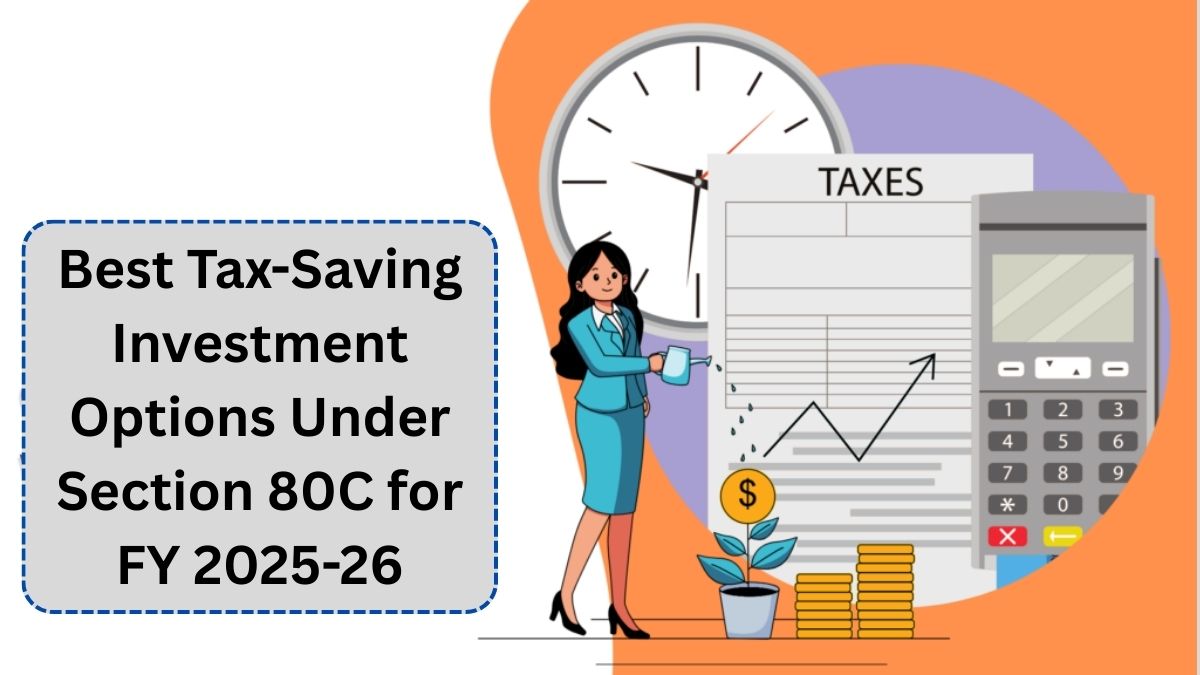As we approach the financial year 2025-26, taxpayers in India are once again looking for effective ways to save on taxes while also building wealth. Section 80C of the Income Tax Act remains one of the most popular avenues for tax-saving investments, offering deductions up to ₹1.5 lakh. But with so many options, choosing the right instrument can be challenging.
This article breaks down the best Section 80C investment options for FY 2025-26, comparing returns, lock-in periods, and suitability for various financial goals.

Understanding Section 80C of the Income Tax Act
Section 80C allows individual taxpayers and Hindu Undivided Families (HUFs) to claim deductions of up to ₹1.5 lakh from their total income, thereby reducing their tax liability. The section includes a wide range of eligible investment and expenditure categories such as life insurance premiums, PPF, ELSS, and more.
Best Tax-Saving Investments Under 80C in FY 2025-26
1. Public Provident Fund (PPF)
Interest Rate: ~7.1% (revised quarterly by the government)
Lock-in Period: 15 years
Tax Treatment: EEE (Exempt on investment, interest, and maturity)
Best For: Risk-averse investors looking for long-term savings
2. Equity Linked Savings Scheme (ELSS)
Expected Returns: 12–15% (market-linked)
Lock-in Period: 3 years (lowest under 80C)
Tax Treatment: EET (Maturity taxed as LTCG above ₹1 lakh at 10%)
Best For: Investors willing to take calculated risks for higher returns
3. Employee Provident Fund (EPF)
Interest Rate: ~8.25%
Tax Treatment: EEE (for contributions and interest if tenure >5 years)
Best For: Salaried individuals; mandatory for employees earning over ₹15,000/month in certain sectors
4. National Savings Certificate (NSC)
Interest Rate: ~7.7% (compounded annually)
Lock-in Period: 5 years
Tax Treatment: Interest is taxable, but reinvested interest qualifies for 80C
Best For: Conservative investors preferring fixed income
5. Tax-Saver Fixed Deposits
Interest Rate: ~6.5%–7.5%
Lock-in Period: 5 years
Tax Treatment: Interest is taxable
Best For: Those seeking guaranteed returns with minimal risk
6. Life Insurance Premiums
Eligibility: Premium must not exceed 10% of the sum assured
Tax Treatment: EEE (if sum assured ≥10x premium)
Best For: Long-term family protection and tax saving
7. Sukanya Samriddhi Yojana (SSY)
Interest Rate: ~8.2%
Eligibility: Girl child under 10 years
Lock-in Period: Until she turns 21
Tax Treatment: EEE
Best For: Parents investing for a daughter’s future
8. Tuition Fees for Children
Eligible For: Up to 2 children per taxpayer
Institutions: Only full-time education in India is valid
Tax Treatment: Deduction under 80C
Best For: Families with school-going children
Comparison Table of Tax-Saving Investments
Investment Option | Interest/Returns | Lock-in Period | Tax Benefit Type | Risk Level |
|---|---|---|---|---|
PPF | ~7.1% | 15 years | EEE | Low |
ELSS | 12–15% | 3 years | EET | High (market-linked) |
EPF | ~8.25% | Until retirement | EEE | Low to Medium |
NSC | ~7.7% | 5 years | Taxable interest | Low |
Tax-Saver FD | ~6.5%–7.5% | 5 years | Taxable interest | Low |
Life Insurance | Varies | 5+ years | EEE | Low |
SSY | ~8.2% | Until age 21 | EEE | Low |
Tuition Fees | NA | Annual | Deduction only | NA |
Choosing the Right Investment
When selecting a tax-saving investment under Section 80C, consider:
Time horizon (short-term vs. long-term)
Risk appetite (low-risk like PPF vs. high-return ELSS)
Liquidity (ELSS has lowest lock-in)
Tax efficiency (EEE options are generally best)
A mix of these instruments can provide both safety and growth potential.
Frequently Asked Questions
Q1: Can I invest in more than one 80C instrument?
Yes. You can spread your ₹1.5 lakh limit across multiple eligible options.
Q2: Are ELSS returns guaranteed?
No, ELSS returns are market-linked. While they offer high potential, there’s also risk.
Q3: What happens if I exceed the ₹1.5 lakh limit?
You won’t get any additional tax benefit beyond the cap, though the investment itself remains valid.
Q4: Is it better to invest monthly or lump sum in ELSS?
SIPs (Systematic Investment Plans) in ELSS help average out market volatility and are often preferred.
Click here to know more.